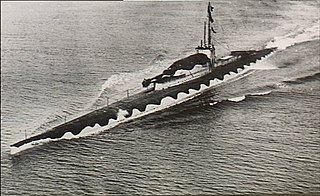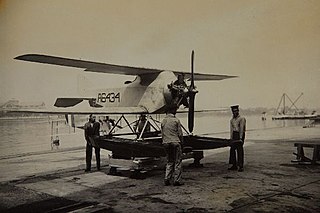
The Arado Ar 231 was a lightweight floatplane, developed during World War II in Nazi Germany as a scout plane for submarines by Arado. The need to be stored inside the submarine necessitated compromises in design that made this single-seat seaplane of little practical use.
Hydroplaning and hydroplane may refer to:

The V-boats were a group of nine United States Navy submarines built between World War I and World War II from 1921 to 1934 under authorization as the "fleet boat" program.

The I-400-class submarine Imperial Japanese Navy (IJN) submarines were the largest submarines of World War II and remained the largest ever built until the construction of nuclear ballistic missile submarines in the 1960s. The IJN called this type of submarine Sentoku type submarine. The type name was shortened to Toku-gata Sensuikan. They were submarine aircraft carriers able to carry three Aichi M6A Seiran aircraft underwater to their destinations. They were designed to surface, launch their planes, then quickly dive again before they were discovered. They also carried torpedoes for close-range combat.

The Aichi M6A Seiran is a submarine-launched attack floatplane designed for the Imperial Japanese Navy during World War II. It was intended to operate from I-400 class submarines whose original mission was to conduct aerial attacks against the United States.

The British Royal Navy M-class submarines were a small class of diesel-electric submarines built during World War I. The unique feature of the class design was a 12-inch (305 mm) gun mounted in a casemate forward of the conning tower.

The Parnall Peto was a small seaplane designed to the British Air Ministry's specification 16/24 in the early 1920s for use as a submarine-carried reconnaissance aircraft.

The B class was a class of 11 submarines, built by Vickers in Barrow-in-Furness for the Royal Navy, and launched in 1904–06. One boat was sunk by a collision in 1912, but the remainder served in World War I. Three boats protected the transfer of the British Expeditionary Force to France in 1914, but were soon relegated to local defence and training duties. Six submarines were in the Mediterranean when the war began and were quickly sent to the Dardanelles to prevent a breakout by the German battlecruiser SMS Goeben and the light cruiser SMS Breslau into the Eastern Mediterranean. B11 ventured into the Dardanelles in December 1914 and sank the elderly Turkish ironclad Mesudiye.

A submarine aircraft carrier is a submarine equipped with aircraft for observation or attack missions. These submarines saw their most extensive use during World War II, although their operational significance remained rather small. The most famous of them were the Japanese I-400-class submarines and the French submarine Surcouf, although small numbers of similar craft were built for other nations' navies as well.

The British U-class submarines were a class of 49 small submarines built just before and during the Second World War. The class is sometimes known as the Undine class, after the first submarine built. A further development was the British V-class submarine of 1942.

The Cox-Klemin XS was a 1920s American experimental scout biplane, the first aircraft to be launched and recovered from a submarine.
The Hrabri class consisted of two submarines built for the Kingdom of Serbs, Croats and Slovenes – Yugoslavia from 1929 on – by Vickers-Armstrong in the United Kingdom. Launched in 1927, the boats were named Hrabri (Brave) and Nebojša (Fearless). Their design was based on that of the British L-class submarine of World War I, and they were built using parts from L-class submarines that were never completed. The Hrabri-class were the first submarines to serve in the Royal Yugoslav Navy (KM), and after extensive sea trials and testing they sailed from the UK to the Adriatic coast of Yugoslavia, arriving in April 1928. They were armed with six bow-mounted 533 mm (21 in) torpedo tubes, two 102 mm (4 in) deck guns, one QF 2-pounder L/39 anti-aircraft gun and two machine guns. Their maximum diving depth was restricted to 55 metres (180 ft) by Yugoslav naval regulations.
The Osvetnik class consisted of two submarines built for the Kingdom of Serbs, Croats and Slovenes – Yugoslavia from 1929 on – by Ateliers et Chantiers de la Loire in Nantes, France. Launched in 1928 and 1929, the boats were named Osvetnik (Avenger) and Smeli (Daring). They were built to a partial double hull Simonot design similar to the French Circé-class submarines. Also known as the Smeli class, they were the second class of submarines to serve in the Royal Yugoslav Navy (KM), and after extensive sea trials and testing they sailed from France to the Adriatic coast of Yugoslavia, arriving in December 1929, where they joined the two larger British-made Hrabri-class submarines to make up the pre-war Yugoslav submarine flotilla. The Osvetnik-class were armed with six 550 mm (22 in) torpedo tubes, one 100 mm (3.9 in) gun, and one 40 mm (1.6 in) anti-aircraft gun, and could dive to 80 metres (260 ft).

The SPL was a submarine borne flying boat designed and built in the USSR from 1931.

The Caspar U.1 was a 1920s German patrol seaplane designed by Ernst Heinkel and built by Caspar-Werke. The U.1 was designed to fit into a cylindrical container to allow it to be carried, then launched from a submarine.

The Macchi M.53 was an Italian reconnaissance floatplane designed and built in the late 1920s by Macchi for the Regia Marina.

The Martin MS-1 was an experimental scout biplane ordered by the United States Navy and was intended to operate from a submarine. It first flew in 1923 and the type was used for tests until 1926 when the project was cancelled.
Hrabri (Brave) was the lead boat of the Hrabri-class submarines; built for the Kingdom of Serbs, Croats and Slovenes– Yugoslavia by the Vickers-Armstrong Naval Yard in the United Kingdom. Launched in 1927, her design was based on the British L-class submarine of World War I, and was built using parts from an L-class submarine that was never completed. The Hrabri-class were the first submarines to serve in the Royal Yugoslav Navy (KM), and after extensive sea trials and testing Hrabri sailed from the UK to the Adriatic coast of Yugoslavia, arriving in April 1928. The submarine was armed with six bow-mounted 533 mm (21 in) torpedo tubes, two 102 mm (4 in) deck guns, one QF 2-pounder L/39 anti-aircraft gun and two machine guns. Its maximum diving depth was restricted to 55 metres (180 ft) by Yugoslav naval regulations.
The Yokosuka E6Y was a Japanese submarine-based reconnaissance seaplane developed at the Yokosuka Naval Air Technical Arsenal for the Imperial Japanese Navy during the 1920s. The prototype first flew as the Yokosho 2-Go in 1929.

Observation seaplanes are military aircraft with flotation devices allowing them to land on and take off from water. Their primary purpose was to observe and report enemy movements or to spot the fall of shot from naval artillery, but some were armed with machineguns or bombs. Their military usefulness extended from World War I through World War II. They were typically single-engine machines with catapult-launch capability and a crew of one, two or three. Most were designed to be carried aboard warships, but they also operated from seashore harbors.
















